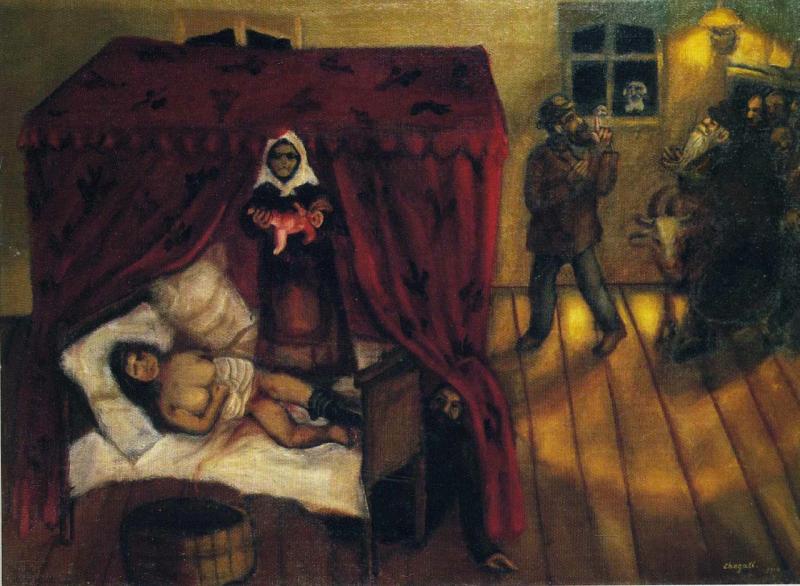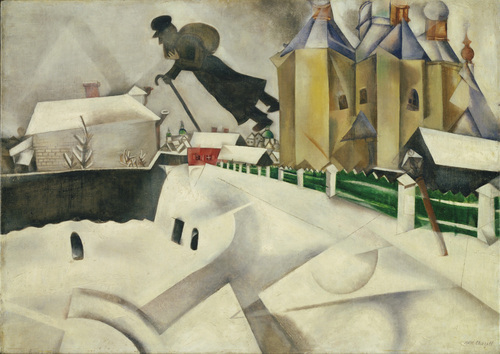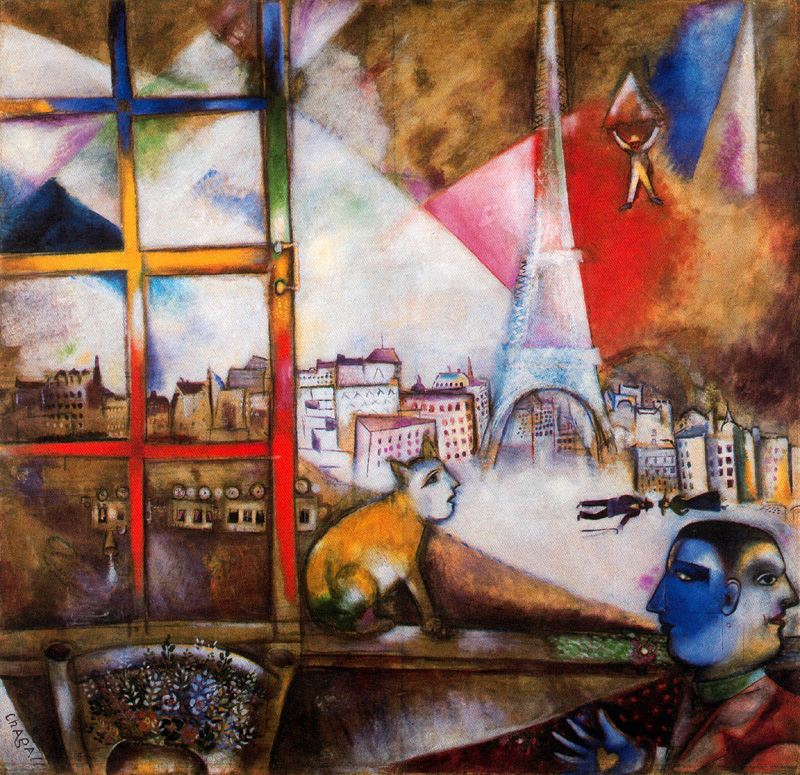Chagall: Modern Master, Tate Liverpool | reviews, news & interviews
Chagall: Modern Master, Tate Liverpool
Chagall: Modern Master, Tate Liverpool
Sugar-coated sentimentality is a default tendency with this Russian modernist, but the charm still wins through

“Charming” is undoubtedly a double-edged word. Along with its perfumed allure, it carries a whiff of insincerity, of something slick and not quite earned. Add “whimsical” and you know you’re in danger of saccharine overload. Chagall is both, plus he’s one of the most popular artists of the 20th century. Does it get any worse?
Marc Chagall was born Moyshe Shagal in Vitebsk, a region now in modern-day Belarus with a big Hassidic population. And though he absorbed some of the ideas of Cubism during his three years in Paris as a young man, his paintings are infused with the mystical and the folklorish, in tender homage to his Russian Jewish background: paintings like The Violinist, 1911-14, in which an old Jewish fiddler appears, shaggy-bearded and green-faced, as one of his stock characters, and Over Vitebsk, 1922 (pictured below), in which one of his wandering Jewish peddlers floats above a snow-covered shtetl with a sack slung over his back.
Stage sets are where Chagall excelled as an artist
The exhibition, the first survey in the UK for 15 years ago, focuses on the years between 1911 to 1922, the period of his most intense creativity, though there is one earlier work, Birth, of 1910 (main picture), painted a year before he left for Paris, aged 23. Reminiscent of a crude Mexican votive painting, the dimly lit scene depicts a mother lying naked and exhausted on blood-soiled sheets, having just given birth. A grim-faced midwife holds the bloodied newborn, while the father cowers under the bed, partly hidden by the puce-coloured curtains pulled back as if opening onto a stage set. Pushing through the door and peeping through the window, which looks out onto a black night, are the villagers, accompanied by an ox, and a rabbi. Raw tenderness and slapstick comedy in one scene.
 In fact, stage sets are where Chagall excelled as an artist. He trained under the great set and costume designer Leon Bakst, who worked with Diaghilev’s Ballets Russes, creating bold designs for Stravinsky’s avant-garde music and Fokine’s daring choreography, and it was to work for Diaghilev that Chagall left for Paris in 1911. It was also during this period when he was exposed to Cubism and the Orphism of his friend Robert Delaunay, who infused his fractured forms with soft, expressive colours. He took all this on board not so much as an intellectual investigation of space and form, but as a stylistic device, creating pastoral poetry with his dream-like scenes of floating lovers, boneless figures elegently swaying and bending any which way and creatures with sphinx-like, wisely benign faces.
In fact, stage sets are where Chagall excelled as an artist. He trained under the great set and costume designer Leon Bakst, who worked with Diaghilev’s Ballets Russes, creating bold designs for Stravinsky’s avant-garde music and Fokine’s daring choreography, and it was to work for Diaghilev that Chagall left for Paris in 1911. It was also during this period when he was exposed to Cubism and the Orphism of his friend Robert Delaunay, who infused his fractured forms with soft, expressive colours. He took all this on board not so much as an intellectual investigation of space and form, but as a stylistic device, creating pastoral poetry with his dream-like scenes of floating lovers, boneless figures elegently swaying and bending any which way and creatures with sphinx-like, wisely benign faces.
The centrepiece of the exhibition are the murals Chagall created in 1920 for the Moscow theatre impresario Alexander Granovsky. Five upright panels for the Russian State Jewish Chamber Theatre depict archetypal Jewish characters: the violinist, the marriage broker, the wedding dancer, the Torah scholar and the wedding jester. There is also the eight-metre-long epic The Wedding Feast in which acrobats and musicians, as well as goats and hens, parade across a dynamic rainbow-coloured backdrop of arcing and diagonal forms.
Having found himself stranded in Russia, first by the outbreak of war, then by the Revolution, Chagall flirted briefly with the geometric abstraction favoured by the new Soviet regime, but although his efforts were always uniquely rooted in his Jewish background – one abstract collage has a cut-out with Hebrew lettering printed across it – his heart was clearly never in it. He’d also been appointed commissar of the Vitebsk art school, which had also recruited Malevich and El Lissitzky, though here Chagall found himself so at odds with the prevailing theories of the Soviet avant-garde that he soon resigned his post.
 Two of Chagall’s best-loved works, Paris Through the Window, 1913 (pictured left), from the Guggenheim in New York, and The Promenade, 1917-18, from the State Russian Museum in St Petersburg, are here. The first features that soaring icon of modernity, the Eiffel Tower, glittering against a vista of blushing pinks and sunny yellows, while a nonchalant human-faced cat stares up at a parachuting figure in the sky. The second shows two lovers, a self-portrait with the artist's future wife Bella - in which Chagall presents himself as a hearty, beaming fellow solidly anchored by gravity, while Bella floats above him like a billowing kite, her hand firmly clasping his. The village spreads out around them like a lustrous miniature toy town.
Two of Chagall’s best-loved works, Paris Through the Window, 1913 (pictured left), from the Guggenheim in New York, and The Promenade, 1917-18, from the State Russian Museum in St Petersburg, are here. The first features that soaring icon of modernity, the Eiffel Tower, glittering against a vista of blushing pinks and sunny yellows, while a nonchalant human-faced cat stares up at a parachuting figure in the sky. The second shows two lovers, a self-portrait with the artist's future wife Bella - in which Chagall presents himself as a hearty, beaming fellow solidly anchored by gravity, while Bella floats above him like a billowing kite, her hand firmly clasping his. The village spreads out around them like a lustrous miniature toy town.
Chagall’s sugar-coated sentimentality is a default tendency, and when he moves away from it, for instance in the glowering Jew in Red, 1915, it feels just a little forced. His later works, post-1922, of which we get a only a small taste, shows that he’d already achieved his most powerful compositions in those short years in Paris and then in the few years just before and after the Russian Revolution. The exhibition ends with Mauve Nude, 1967. This might lack something of the simplicity and directness of the earlier work, but the colours still sing out.
Share this article
The future of Arts Journalism
You can stop theartsdesk.com closing!
We urgently need financing to survive. Our fundraising drive has thus far raised £49,000 but we need to reach £100,000 or we will be forced to close. Please contribute here: https://gofund.me/c3f6033d
And if you can forward this information to anyone who might assist, we’d be grateful.

Subscribe to theartsdesk.com
Thank you for continuing to read our work on theartsdesk.com. For unlimited access to every article in its entirety, including our archive of more than 15,000 pieces, we're asking for £5 per month or £40 per year. We feel it's a very good deal, and hope you do too.
To take a subscription now simply click here.
And if you're looking for that extra gift for a friend or family member, why not treat them to a theartsdesk.com gift subscription?
more Visual arts
 'We are bowled over!' Thank you for your messages of love and support
Much-appreciated words of commendation from readers and the cultural community
'We are bowled over!' Thank you for your messages of love and support
Much-appreciated words of commendation from readers and the cultural community
 Ithell Colquhoun, Tate Britain review - revelations of a weird and wonderful world
Emanations from the unconscious
Ithell Colquhoun, Tate Britain review - revelations of a weird and wonderful world
Emanations from the unconscious
 Rachel Jones: Gated Canyons, Dulwich Picture Gallery review - teeth with a real bite
Mouths have never looked so good
Rachel Jones: Gated Canyons, Dulwich Picture Gallery review - teeth with a real bite
Mouths have never looked so good
 Yoshitomo Nara, Hayward Gallery review - sickeningly cute kids
How to make millions out of kitsch
Yoshitomo Nara, Hayward Gallery review - sickeningly cute kids
How to make millions out of kitsch
 Hamad Butt: Apprehensions, Whitechapel Gallery review - cool, calm and potentially lethal
The YBA who didn’t have time to become a household name
Hamad Butt: Apprehensions, Whitechapel Gallery review - cool, calm and potentially lethal
The YBA who didn’t have time to become a household name
 Bogancloch review - every frame a work of art
Living off grid might be the meaning of happiness
Bogancloch review - every frame a work of art
Living off grid might be the meaning of happiness
 Do Ho Suh: Walk the House, Tate Modern review - memories are made of this
Home sweet home preserved as exquisite replicas
Do Ho Suh: Walk the House, Tate Modern review - memories are made of this
Home sweet home preserved as exquisite replicas
 Ed Atkins, Tate Britain review - hiding behind computer generated doppelgängers
Emotions too raw to explore
Ed Atkins, Tate Britain review - hiding behind computer generated doppelgängers
Emotions too raw to explore
 Echoes: Stone Circles, Community and Heritage, Stonehenge Visitor Centre review - young photographers explore ancient resonances
The ancient monument opens its first exhibition of new photography
Echoes: Stone Circles, Community and Heritage, Stonehenge Visitor Centre review - young photographers explore ancient resonances
The ancient monument opens its first exhibition of new photography
 Hylozoic/Desires: Salt Cosmologies, Somerset House and The Hedge of Halomancy, Tate Britain review - the power of white powder
A strong message diluted by space and time
Hylozoic/Desires: Salt Cosmologies, Somerset House and The Hedge of Halomancy, Tate Britain review - the power of white powder
A strong message diluted by space and time
 Help to give theartsdesk a future!
Support our GoFundMe appeal
Help to give theartsdesk a future!
Support our GoFundMe appeal

Add comment